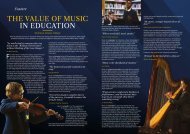You also want an ePaper? Increase the reach of your titles
YUMPU automatically turns print PDFs into web optimized ePapers that Google loves.
Individuals<br />
25<br />
Marlene Dietrich: Re-defining modern<br />
German culture and sexual liberalism in<br />
the 20 th century<br />
G<br />
erman culture has undergone significant<br />
shifts and developments<br />
throughout the years, with the<br />
most noteworthy periods of change being<br />
the liberal Weimar Germany during the<br />
inter-war years and also the decades that<br />
came after the Second World War. <strong>The</strong><br />
theatre, cinema, cabaret and fashion were<br />
the four areas that underwent the largest<br />
change in Germany. Indeed, all of these<br />
areas were underpinned by lurking notions<br />
of sexual liberalism which were only<br />
popularised thanks to one woman, Marlene<br />
Dietrich. Not only did Dietrich become<br />
Germany’s most famous cabaret star<br />
and actress but, as an openly bisexual<br />
women at a time before the idea of an<br />
LGBT community even existed, she set<br />
herself against traditional values through<br />
her performances and her fashion not only<br />
to taunt those values, but also to tempt the<br />
world into an age consisting of political,<br />
social and sexual freedoms.<br />
In the theatre in the post-Second World<br />
War period, new acting techniques and<br />
different styles of performance began to<br />
occur, such as street performances, which<br />
allowed the public to be more involved in<br />
theatre. Performances in general often reflected<br />
politics and society, making the<br />
theatre attractive to the public by bringing<br />
both comedy and drama to the public political<br />
sphere. <strong>The</strong>atre acted as a mirror<br />
held up to the audience to demonstrate<br />
how their society and their politics were<br />
conveyed. For example, bourgeois society<br />
was heavily critiqued with very blunt acting<br />
methods such as actors appearing on<br />
stage sitting on the toilet. Alongside this,<br />
cabaret developed as a more risqué form<br />
of entertainment but, indeed, it is this sort<br />
of debauchery that made it such an<br />
enticing spectacle. For example, naked<br />
dancing and nightclubs became very popular<br />
and, by the<br />
end of the 1930s,<br />
Berlin rivalled<br />
Paris as the cultural<br />
capital of<br />
Europe with<br />
over 40 theatres<br />
and many nightclubs.<br />
Indeed,<br />
the most famous<br />
actress appearing<br />
in such<br />
nightclubs and<br />
on such cinema<br />
screens was<br />
Marlene Dietrich.<br />
Not only<br />
was she a cultural<br />
icon of<br />
Weimar Germany,<br />
but she<br />
Dietrich in ‘<strong>The</strong> Blue Angel’<br />
also transcended German<br />
borders and was a star in Hollywood too,<br />
where she became most famous. Marlene<br />
can be admired not only for seeking to<br />
challenge gender norms through her provocative<br />
costumes, but also for being publicly<br />
bisexual and for her work during the<br />
Second World War against the Nazi regime.<br />
<strong>The</strong>refore, Marlene Dietrich must be<br />
considered a cultural and global icon of<br />
the 20 th Century as her impact on popular<br />
culture can still be seen today.<br />
During the 1920s, Marlene Dietrich<br />
worked on the stage and in film in both<br />
Berlin and Vienna playing roles in plays<br />
such as Shakespeare’s Taming of the Shrew<br />
and in films such as Tragedy of Love (1923)<br />
where she met her future husband. However,<br />
it is her performances in musicals<br />
such as Broadway that attracted most


















